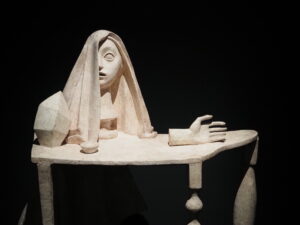Surrealism in Paris
October 2024
Surrealism, as many of us had conceived of it for years, should not be considered as extant except in the a priori nonspecialization of its effort. I hope it will be considered as having tried nothing better than to cast a conduction wire between the far too distant worlds of waking and sleep, exterior and interior reality, reason and madness, the assurance of knowledge and of love, of life for life and the revolution, and so on. —André Breton, Les Vases communicants (1932; English trans. 1990)
In the spirit of a thought experiment, I offer my time spent in Paris attending the International Society for the Study of Surrealism (ISSS) conference on Surrealism, one week before the American election, as charged with the co-presence of dream and reality. The first reality was Paris itself as elective site of a transformative moment—the 100th anniversary of the First Manifesto of Surrealism. Being in Paris at that time, as it condenses all time passing between that moment and the present, had the feeling of co-presence of many moments all aware of each other and on the same level though not directly in contact. The crowds going about their business under a gray sky, during a school holiday where there was some release of tension and many children and families on the street, were not in direct contact with us streaming in cab or Uber to specific destinations, for instance the conference venue at American University Paris (AUP). Those presenting in multiple rooms, with visual aids and in three languages, were not aware of the cabs or Ubers picking passengers up and dropping them off. Just so, the meticulously curated book display of surrealism was not aware of the content delivered above. The array of editions, including many facsimiles of original texts, had a remote and uncanny feeling, as with the difference between books being opened and closed. The conference, as site for special knowledge (of “specialists in revolt”), was removed from the “nonspecialization” of lifeworld unaware of it outside.
To put one’s finger on this effect recall Marcel Duchamp’s effort to encapsulate 50 cc. of Paris air in an ampule, obtained by purchase from a pharmacist, as calling card for his patron Walter Arensberg. The readymade effect just is that separation between object and meaning that opens the discrepant analogy between dream and reality. I proposed to assess that relationship in a series of scholarly interventions: specialized content for the cognoscenti, those of us attuned to the surrealist program but with lifeworld implications. To do so, I put out a Call for Papers (here); contacted fellow poets and scholars; and organized an event comprising parallel sessions. Continuing the analogy to communicating vessels, the idea was to establish a level between singular elements not in direct contact with each other and generalize that relation. The rubric of “Discrepant Analogies” was both general and particular, as our contributions would reveal. On the one hand, it took up the veiled communication between surrealism and American poetry where there are few specific conduction wires to be found. But it was also about a mode of communication through absence, akin to the unconscious. The proposal was accepted and we were scheduled as first on the program on Days 1 and 2, offering prompts perhaps for what might then unfold.
Discrepant Analogy 1: Transpositions of Surrealism (Chair : Barrett Watten)
Abigail Lang, Université Paris Cité (FR), «From ‘Mantis’ to Found Objects: Louis Zukofsky’s Surrealist Musings»
Barrett Watten, Wayne State University (USA), «Discrepant Analogies: Transposition of Praxis, Surrealism to Language»
Gail Scott (CAN), «Refus global: Still a Guiding Light in Québec Art and Culture at 76»Discrepant Analogies 2. Transpositions of Surrealism (Chair: Carla Harryman)
Carla Harryman, Eastern Michigan University (US), «Houses as Bodies and Houses That Won’t Be Described: Leonora Carrington and Poupeh Missaghi»
Milena Arsich, Université Strasbourg, (FR), «The Collage of Verbal Materials, from Surrealism to Language Poets»
Miriam Ould Aroussi, Université Paris Cité, (FR) «Tan Lin Is Surrealist in Attention»
To summarize is not the point; the work will make its way into print and be read for their nuance and detail. But general frameworks arise: the presentations were, in quite different ways, concerned with the communicating (non)relation of surrealism to works that might be elucidated via their (non)relation to it. This was not a relation of priority or lineage but more of an unconscious or uncanny or analogous effect that occurs when a surrealist concept or object or writing conveys a possibility not directly stated in it. Something like an unconscious (and thus discrepant) transmission occurs (by analogy). Louis Zukofsky, the objectivist poet, is seldom seen as a descendant of surrealism, and canonical history discourages it (both in America, after Hugh Kenner’s High Modernism, and in France after Zukofsky’s discovery in the 70s, which put paid to surrealist influence for many). But there is a conduction wire if one knows where to look—depending, in fact, on some relation to the descriptive terms that are often used to specify precisely what surrealism is. In her paper, Abigail Lang established a convincing series of points of (non)contact, in concept and lore, between surrealism and objectivism, in Zukofsky’s Depression-era “Mantis” and explanatory text “Mantis: An Interpretation” (1934). These twin texts, working on as many levels as Dante, allegorize the erotic, destructive praying mantis from Roger Caillois’s article in Minotaure no. 5 (1933), which Zukofsky knew, in terms of class politics. The mantis itself is an objet trouvé—like Nadja—but even more outside the Symbolic Order of recognition. The unconscious analogy is in the relation between poem and explanation, much like the use of “reading out” everywhere in Breton’s theoretical texts, following Freud’s Interpretation of Dreams. (“Reading out” is a term of art used here to mean the unpacking of a condensed or elusive text on a more extensive plane of language, be it narrative or expository.)[1] André Breton, in Les Vases communicants (1932)—an example of “reading out”—speculated that the relation between a poem whose meanings are yet to be revealed and an explanatory text like a dream interpretation completely satisfies the psychic relation between the two, which still remains productive—the basis principle of discrepant analogy. “Reading out” Zukofsky’s material allegory brings objectivism in line with surrealist practices, with many points of productive contact, both seeking to find their experiential “level.”
The question is the larger one of transmission: the influence at a distance of the conscious method and unconscious process that Breton figures through the “level” relationship of communicating vessels. This mode of transmission is one of many: the automatic message (the spontaneity of “a man cut in half by a window,” as both language and image); the surrealist encounter with like-minded poets (same) or objets trouvés (different); the collective dynamics of the movement itself; and the specter of “revolt” against institutional and ideological oppression that drives the entire project. In my presentation, I began with Breton’s challenge to consider surrealist method as not arcane or hieratic but everyday and “nonspecialist,” such that (redeemed) experience itself would be the final horizon of the method. This thread works through the text of Les Vases communicants in the details of a “discrepant analogy” of dream interpretation and Marxist materialism. It is important that the two frameworks cannot be the same, and yet they can arrive at the same “level”—in the figure of the vessels themselves as interpretants. What Breton is seeking is the adequation of desire as lived experience, which must be accomplished both in the “inner series” of dream, as processing the day’s materials in the moment of waking, and the “outer series” of desires and their outcomes. Such desires could be to restore the “lost object” of Breton’s break-up with Suzette Muzard, or it could be the politics of revolutionary movements as missing the “whole” they desire (and may never achieve). The method itself is one I sought to draw into the contemporary moment: of the dream (in the present case a nightmare) we are subject to daily, and the displacement of ourselves we suffer in our incompletion, which may be that of a person or a group of persons now lost to us forever. This is what the present moment feels like—”something is not working,” in Breton’s anticipatory text.
Reconstituting the person or the group who are missing might be a good reason to organize a series of papers on the topic of surrealism to be delivered at an academic conference, seen as a collective action whose political destiny is always kept in the forefront. Is this exaggerating? Or a method of “reading out” experience itself to show how it complements the incomplete meanings of the dream? In Gail Scott’s intervention into the politics of hexagonal surrealism from the perspective of Québecois automatism of the 40s, the stakes were to reconfigure their unrecognized call for collective revolt as a lost object of surrealism’s global diffusion. The politics of language in Québec—the oppression of the French majority by dominant English, of the Left through the Padlock Laws of the 30s, but also the refusal of recognition of Québec from the Paris metropole then and now—demand alternate routes for Québecois writing, seen in emerging writers who look back on the collectively authored Refus global (1943). Carla Harryman’s teasing out of structures, boundaries, and transgression in two texts—Leonora Carrington’s The Hearing Trumpet and Poupeh Missaghi’s twenty-first century anti-novel Trans(re)lating House One—show a relation of discrepant analogy that mirrors an experience of global displacement in both authors. Consider here, too, the loss of any “house” as stable structure in both authors’ global displacement, motivating desire. Seeking similarity in difference, Milena Arsich drew out the multiple contrasts and differences between surrealist uses of collage, going beyond Dada in seeking an oneiric continuity (not just shock effect) between dissociated fragments. The “cement” between elements, in my hearing, is common to both projects and leads to “meta” levels of sentence and discourse in Surrealism and Language. Miriam Ould Aroussi ended our collective session by anatomizing the phenomenological uncanny in Tan Lin’s ambient poetics, which she connected both to surrealist liminality and Duchampian/Warholian distancing effects from a lost object—with a precision that was itself otherworldly.
Returning to the notion of a “nonspecialist” surrealism as the stakes of the movement and its transmission, I offered an instance from our political moment—one week before the catastrophe—as producing the capillary tissue between dream and world that we live. I experienced this in a “waiting room” of allegorical import that was both a private and public event, which I will write about in a subsequent post. In a discrepant analogy, I would transpose the notion of a waiting room to our experience of the conference itself, in the everyday lifeworld of Paris to which it was and was not connected. A space and time open up by which our processes are articulated and our purposes made clear. This was a return to the conjunction of dream, object, desire, and writing that the surrealists proposed as their (in)communicable legacy.
Notes and links
[1] “Reading out” is not merely interpretation but a recasting of the manifest or latent content of text A onto a more extended text B. The point is that the difficult or ambiguous or hidden or transgressive content of text A is not lost; it is preserved and developed in text B. Zukofsky mentions La vita nuova of Dante as his prime example of “reading out,” though Freud would be available as well. “Mantis” and the first half of “A”–9 are the prime examples in his work. In Language writing, Kit Robinson’s “Seven Days in Another Town” is an example of “reading out,” as is Ron Silliman’s Albany. My 101 glosses on the stanzas of “Plan B” are an aggressive deployment of “reading out” of the bastard president, which wants to be completed in the action of “Plan B.”
Links: “Document 104: Discrepant Analogy” [here]
“Entry 46: Invocation of Fourier” [here]
“Entry 54: The Transmission of Poetry” [here]














